a Toronto/Martha & the Muffins annotated bibliography
by Leonard Nevarez on Sep 24, 2014 • 10:03 am 1 CommentFor the Martha and the Muffins book project, the first task I’ve set for myself is to dive into the literature. Toronto is fairly terra incognito for me; to contextualize the geographic sensibilities embodied in the band’s music and career, an appreciation of its urban history and geography is in order. Also, Canadianness and ‘Canada’ evoke a massive set of cultural connotations and contradictions that Martha and the Muffins are part of. Although their status as a quintessentially ‘Canadian’ rock group isn’t an angle I’ll necessarily emphasize in this project, some familiarity with these broader themes in Canadian studies is required. I’m probably most versed in the history of Toronto as a music city, but there are still so many books (some of which cover Martha and the Muffins specifically) that I want to bone up on for this project.
To that end, I’ve generated a preliminary bibliography, which I share and annotate here. It reflects what a small grant from Vassar College could buy me on Amazon.com; necessarily it’s biased toward in-print and Toronto-centric titles. I very much welcome further suggestions, which I invite you to leave in the comments section.
TORONTO: GEOGRAPHY, POLITICS, HISTORY
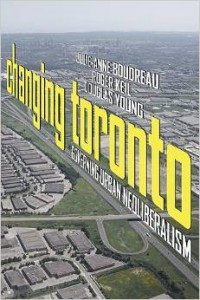 Boudreau, Julie-Anne, Roger Keil and Douglas Young. 2009. Changing Toronto: Governing Urban Neoliberalism. Toronto: University of Toronto Press.
Boudreau, Julie-Anne, Roger Keil and Douglas Young. 2009. Changing Toronto: Governing Urban Neoliberalism. Toronto: University of Toronto Press.
A neomarxian sociospatial study of the Toronto region centered around 1995-2005, a period bracketing the metropolitan amalgamation that turned Toronto governance, services, and (a crucial element in the Martha and the Muffins story) place identity upside down. Diving into the Toronto urban studies literature, one of the first things I learned is that the city should be understood in distinct before-and-after-1998 phases. Before 1998, the City of Toronto referred to the historic central city, and “the suburbs” were five municipalities that surrounded it: Etobicoke, York, North York, East York, and Scarborough. After 1998, the provincial Ontario government designated these six municipalities the new “City of Toronto,” thereby recognizing and designating greater resources to the ascendant outer suburbs, which include massive municipalities (Mississauga and Brampton rank among the top 10 Canadian cities in terms of population), growth corridors and borders, and expansion projects (like a new airport) intended to assert Toronto’s global status. Bourdreau et al. assess the rationale and costs of these changes: class restructuring, environmental strain, privatization of public resources, and an exclusionary “creative city” paradigm.
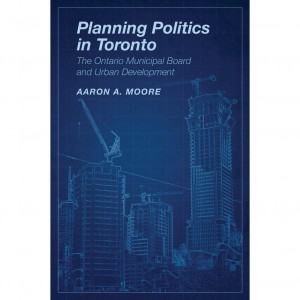 Moore, Aaron A. 2013. Planning Politics in Toronto: The Ontario Municipal Board and Urban Development. Toronto: University of Toronto Press.
Moore, Aaron A. 2013. Planning Politics in Toronto: The Ontario Municipal Board and Urban Development. Toronto: University of Toronto Press.
A key player in the sprawl that has consumed the Toronto city-region is the Ontario Municipal Board, a quasi-judicial appeal body for land-use planning to which the Toronto City Council and other elected bodies must answer. A political scientist, Moore reviews its planning and governance powers and engages the political economy framework on urban development. The OMB reveals key differences in how Canada organizes pro-growth coalitions: by taking the authority of planning away from city politicians, it creates an opening for their anti-growth advocacy (unconventional in urban political economy), even as it deprives them of important powers to do anything about growth.
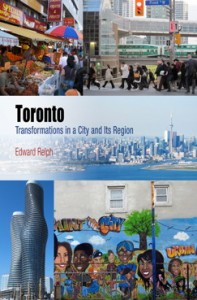 Relph, Edward. 2013. Toronto: Transformations in a City and Its Region. Philadelphia: University of Pennsylvania Press.
Relph, Edward. 2013. Toronto: Transformations in a City and Its Region. Philadelphia: University of Pennsylvania Press.
One of the newer titles in this bibliography, this book introduces the complex patterns of growth and settlement in the Toronto city-region and “Greater Golden Horseshoe” that encompasses the Hamilton metropolitan area further south along Lake Ontario. A long-time Torontonian and emeritus geographer at University of Toronto Scarborough, Relph surveys the history of regional change in and around Toronto and documents the patterns of population growth, economic and cultural diversification, and sometimes breath-taking densities and landscapees that have transformed the city and especially its dynamic outer suburbs. Relph is clearly fascinated by these outerlying areas, which seem to have confined the City of Toronto to its present roles as global cultural-media center and planning model.
 Sewell, John. 2009. The Shape of the Suburbs: Understanding Toronto’s Sprawl. Toronto: University of Toronto Press.
Sewell, John. 2009. The Shape of the Suburbs: Understanding Toronto’s Sprawl. Toronto: University of Toronto Press.
Sewell is a former Toronto City Councilmember and author of the 1993 book, The Shape of the City: Toronto Struggles with Modern Planning. This book appears to direct his historical interests and considerable experience with city planning and politics to the period after metropolitan amalgamation. The subtitle as well as chapters like “A Triumph for Suburban Values” suggest his analysis reflects the classically urban, transit-oriented values associated with the old City of Toronto.
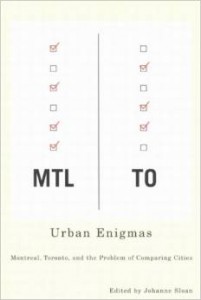 Sloan, Johanne (ed.). 2007. Urban Enigmas: Montreal, Toronto, and the Problem of Comparing Cities. Montreal: McGill-Queen’s University Press.
Sloan, Johanne (ed.). 2007. Urban Enigmas: Montreal, Toronto, and the Problem of Comparing Cities. Montreal: McGill-Queen’s University Press.
An edited academic volume, this is the second book to come from the project, The Culture of Cities: Montreal, Toronto, Berlin, Dublin, supported by the Social Science and Humanities Research Council of Canada. [Note to self: look for the other titles, of which at least five are mentioned.] The authors compare Montreal and Toronto but, more to the point, examine the act of comparison as an entry into modes of local, provincial, Canadian, and global self-representation.
CANADIAN MUSIC & POPULAR CULTURE
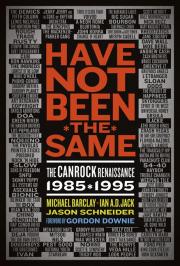 Barclay, Michael, Ian A.D. Jack and Jason Schneider. 2011. Have Not Been the Same: The CanRock Renaissance 1985-1995. Toronto: ECW Press.
Barclay, Michael, Ian A.D. Jack and Jason Schneider. 2011. Have Not Been the Same: The CanRock Renaissance 1985-1995. Toronto: ECW Press.
This journalistic, quote-heavy tome (over 700 pages!) covers the decade before Canadian rock finally broke through with Alanis Morrissette, the Barenaked Ladies, Sarah MacClachlan and others. It’s emblematic how this historicization excludes the key years for Martha and the Muffins, since the narrative here is an oft-repeated one. Namely, Canadian musicians overcome cultural inferiority and an indifferent national music sector, both of which led earlier musicians from Joni Mitchell and Neil Young to Toronto’s punk and new wave scene to look beyond the border for artistic and commercial vindication, to create music reflecting a distinctly Canadian experience. Still, I’ll tip my hat to any book that gives this much attention to the gonzo It Came From Canada compilation series released by Og Records out of Montreal.
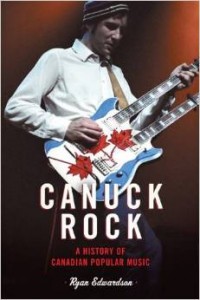 Edwardson, Ryan. 2009. Canuck Rock: A History of Canadian Popular Music. Toronto: University of Toronto Press.
Edwardson, Ryan. 2009. Canuck Rock: A History of Canadian Popular Music. Toronto: University of Toronto Press.
Responding to such essentialist narratives, Ryan Edwardson examines the historical construction of ‘Canadian Rock.’ This cultural value, which isn’t the same as rock music made by Canadians, was really the product of the famous “CanCon” legislation requiring national radio stations to play a minimum quota (originally 30 percent of Canadian recorded music. Edwardson documents how CanCon was originally about economic opportunity, not the cultural nationalism that the Pierre Trudeau government later promoted, and that it was always strenuously resisted by English-language Canadian radio. The contrast to the almost immediate coalition between Quebec nationalists, French-speaking Canadian musicians, and Quebec radio underscores how the cultural ideal behind an (English-speaking) ‘Canadian’ rock music developed gradually, contingently, and not without regular opposition by opportunistic parties (hello, Bryan Adams!).
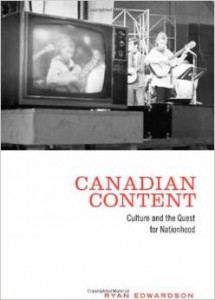 Edwardson, Ryan. 2008. Canadian Content: Culture and the Quest for Nationhood. Toronto: University of Toronto Press.
Edwardson, Ryan. 2008. Canadian Content: Culture and the Quest for Nationhood. Toronto: University of Toronto Press.
The prior book by historian Ryan Edwardson to Canuck Rock, this title takes a broader pass on the ideals and legislation motivating CanCon standards. What it loses in the depth with which his later book examines the Canadian music industry, it gains in historical scope, as Edwardson charts the evolution of Canadian nationalism starting with the country’s 1920s transition from country to nation.
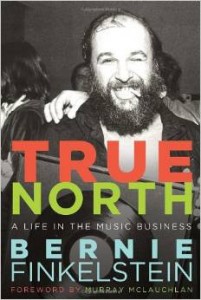 Finkelstein, Bernie. 2012. True North: A Life Inside the Music Business. Toronto: McClelland & Stewart.
Finkelstein, Bernie. 2012. True North: A Life Inside the Music Business. Toronto: McClelland & Stewart.
This is a memoir by a pioneer of the Canadian music sector — specifically, those entrepreneurs, agencies and companies who promoted Canadian musicians writing and performing original material in a country where cover bands reigned supreme and English-speaking radio played U.S. and U.K. hits. Bernie Finkelstein came to notice as the manager of the now-forgotten Toronto hippie group the Paupers; after a promising 1967 tour of the U.S., Albert Grossman arrived to squeeze Finkelstein out of the band’s management duties. Undeterred, Finkelstein launched True North Records in 1970, a Canadian indie that waved the flag of cultural nationalism and promoted Canadian artists to the world with a secret weapon: the distribution muscle of U.S.-based Columbia Records. The stable of artists that Finkelstein brought to widespread attention, like Bruce Cockburn and Murray McLauchlan, typically represented pre-punk folk rock, although Finkelstein was connected to Toronto new wavers Rough Trade (who were themselves Yorkville survivors from the sixties).
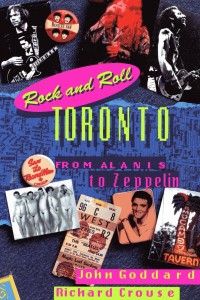 Goddard, John and Richard Crouse. 1997. Rock and Roll Toronto: From Alanis to Zeppelin. Toronto: Doubleday Canada.
Goddard, John and Richard Crouse. 1997. Rock and Roll Toronto: From Alanis to Zeppelin. Toronto: Doubleday Canada.
Written for easy consumption and Toronto sightseeing, this book connects local landmarks to a mostly predictable set of historical anecdotes (here’s where Keith Richards was tried on drug charges, here’s where John & Yoko announced the ill-fated post-Woodstock Music and Peace Conference) and local origins (here’s where the Cowboy Junkies recorded The Trinity Sessions, here’s where Celtic harpist Loreena McKennett used to busk). Canada’s punk and new wave era is relegated to a single chapter on the Ontario Place Forum, site of the 1980 “riots” outside a Teenage Head concert. The most interesting bits in this book focus on little-known Torontonians who played big roles in pop history: Mary Hawkins (who introduced the Band to Bob Dylan), Walt Grealis (original advocate of CanCon legislation), Cathy Evelyn Smith (teen mother of Levon Helms’ child, later accused of overdosing John Belushi in Los Angeles).
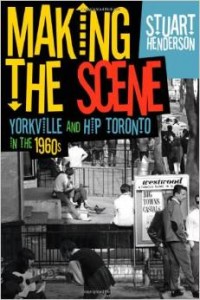 Henderson, Stuart. 2011. Making the Scene: Yorkville and Hip Toronto in the 1960s. Toronto: University of Toronto Press.
Henderson, Stuart. 2011. Making the Scene: Yorkville and Hip Toronto in the 1960s. Toronto: University of Toronto Press.
Yorkville ranks as one of the great countercultural “villages” of the 1960s, alongside Greenwich Village and the Haight-Ashbury. Perhaps its importance is overlooked because, unlike those places, Yorkville’s signature musicians (Neil Young, the future Steppenwolf, etc.) had to leave Canada to find fame. But Yorkville sent tremors through Toronto and the whole country in the 60s, becoming a premiere stage for sex-and-drugs liberation; a crowded destination for suburban teenagers and desperate runaways; and the setting for a torrid decline, fueled by hard drugs and violence, that brought an end to Canada’s countercultural dream. As this academic history attests, Yorkville was also the first neighborhood where ethnic immigrants, cappuccino and boutique commerce laid the foundation for a hip scene in a notoriously conservative city. Henderson emphasizes the fluid boundaries between old-timers and hippies, greasers and bikers, suburban tourists and villager insiders in the years before Yorkville became a posh, sterile urban address.
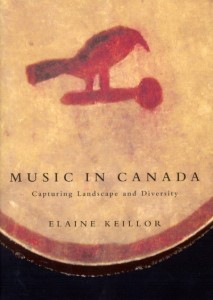 Keillor, Elaine. 2006. Music in Canada: Capturing Landscape and Diversity. Montreal: McGill-Queen’s University Press.
Keillor, Elaine. 2006. Music in Canada: Capturing Landscape and Diversity. Montreal: McGill-Queen’s University Press.
An extensive musicological text that surveys a long history from traditional styles and historical influences (from the First Peoples and British and French colonialists), to Canadian composers and conservatories, to the mass-media proliferation of jazz, country, folk and popular musics before and after CanCon. Keillor pursues seriously the tropes of ‘Canadian’ music, which is essentially tied to landscape evocation, local and ethnic heritage, and cultural syncretism.
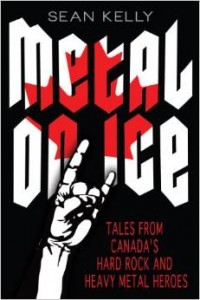 Kelly, Sean. 2013. Metal on Ice: Tales from Canada’s Hard Rock and Heavy Metal Heroes. Toronto: Dundurn.
Kelly, Sean. 2013. Metal on Ice: Tales from Canada’s Hard Rock and Heavy Metal Heroes. Toronto: Dundurn.
Anvil have their movie, Voivod their critical credibility, but whither the forgotten Canadian journeymen (and women) of 80s hair metal: Helix, Kick Axe, Honeymoon Suite, Coney Hatch, Headpins, Killer Dwarfs, Slik Toxik, Harem Scarem, and so on? Their collective story of banging against industry indifference and unforgiving Canadian winters to pursue the rock’n’roll dream is told in this easily digestible book.
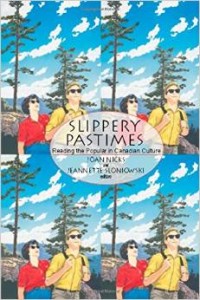 Nicks, Joan and Jeannette Sloniowski (eds.). 2002. Slippery Pastimes: Reading the Popular in Canadian Culture. Waterloo, ON: Wilfrid Laurier University Press.
Nicks, Joan and Jeannette Sloniowski (eds.). 2002. Slippery Pastimes: Reading the Popular in Canadian Culture. Waterloo, ON: Wilfrid Laurier University Press.
A multidisciplinary, academic volume that examines a variety of cultural forms and genres, from TV programming and sports to advertising and postage stamps, to address the “slippage” of genres, messages, and cultural ownership in Canadian popular culture. A critical inquiry into ‘Canadianness’ motivates many of these chapters, including two valuable ones about Canadian popular music. A chapter by Bart Testa and Jim Shedden, “In the Great Midwestern Hardware Store: The Seventies Triumph in English-Canadian Rock,” offers a “socio-economic and geographical rather than aesthetic” analysis of the cultural impact of Rush and Bachman Turnover Overdrive across North America’s industrial midwest. Will Straw, in “Dilemmas of Definition,” reviews the “essentialist” and “compensatory” views of Canadian popular culture before arguing for the significance of a more mundane, often imitative kind of popular culture rooted in the practices and movements of everyday life.
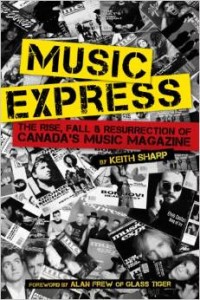 Sharp, Keith. 2014. Music Express: The Rise, Fall & Resurrection of Canada’s Music Magazine. Toronto: Dundurn.
Sharp, Keith. 2014. Music Express: The Rise, Fall & Resurrection of Canada’s Music Magazine. Toronto: Dundurn.
A memoir by the founder and editor of Music Express, which began in 1976 as Alberta Music Express based in Calgary covering Canadian hard rock and pop; by the 80s, it dropped the Alberta, moved to Toronto, and expanded into a national publication covering international artists. Martha and the Muffins get mention as featured artists at the first annual Music Express Awards, in 1983, which Sharp organized as a rejoinder to the controversy surrounding the Juno Awards. The author drops names of Canadian musicians and industry figures all over the place; behind-the-scenes machinations and controversies are presented frankly, if without much analysis.
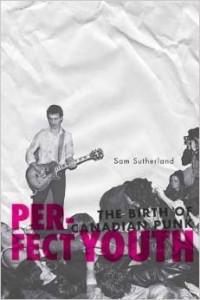 Sutherland, Sam. 2012. Perfect Youth: The Birth of Canadian Punk. Toronto: ECW Press.
Sutherland, Sam. 2012. Perfect Youth: The Birth of Canadian Punk. Toronto: ECW Press.
In this enjoyable overview of the first outbursts of Canadian punk, Sutherlandstrives for regional parity (hello Winnipeg! hello, Saskatchewan!) and generic legacies. Toronto legends like the Viletones, the Diodes and the Curse get their expected due, but so do the pre-punk, Sparks-inspired Dishes, cited here as queercore progenitors; the Dishes’ stronghold in the Ontario College of Art and the Beverly Tavern became an important base for Martha and the Muffins. Of course, the essentials regarding D.O.A., Teenage Head, the Subhumans and many others are also covered. Interestingly, this book began as Sutherland’s senior project at Ryerson University in Toronto.
 Worth, Liz. 2011. Treat Me Like Dirt: An Oral History of Punk in Toronto and Beyond, 1977-1981. Toronto: ECW Press.
Worth, Liz. 2011. Treat Me Like Dirt: An Oral History of Punk in Toronto and Beyond, 1977-1981. Toronto: ECW Press.
A very generous (370 pages of 2-columns in 9 font!) history of Toronto’s first wave of punk, which took off immediately after the subcultural explosions in New York and London — too soon for its pioneers to generate anything but fear and confusion among media gatekeepers and the public at large. With its massive archive of first-hand reminiscences and interpretations, Treat Me Like Dirt is an essential source for anyone interested in punk trailblazers like the Viletones (whose frontman Steven Leckie, a.k.a. Nazi Dog, comes off as a supreme dickhead), the Diodes, the Curse, the Ugly, as well as the possibly more significant Hamilton groups Teenage Head and Simply Saucer. Importantly, Worth gives female musicians and scenesters equal voice in telling the story of an inner city punk scene populated largely by suburban misfits. Martha Johnson and Mark Gane are among the book’s informants, although the time period covered here focuses their comments more on their old OCA bands, the Doncasters and Oh Those Pants!
MARTHA & THE MUFFINS STUDIES
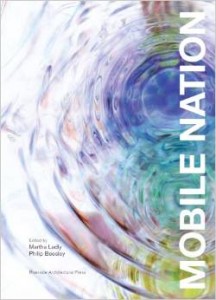 Ladly, Martha and Philip Beesley (eds.). 2008. Mobile Nation: Creating Methodologies for Mobile Platforms. Toronto: Riverside Architetural Press.
Ladly, Martha and Philip Beesley (eds.). 2008. Mobile Nation: Creating Methodologies for Mobile Platforms. Toronto: Riverside Architetural Press.
After giving up a professional music career by the mid-1980s, original Muffin Martha Ladly resumed her OCA interests in fine arts, graphic design, and media theory, most notably working as head of design at Peter Gabriel’s Real World throughout the 1990s. In the new millenium she obtained degrees at York University and concurrently began teaching back where it all began for Martha and the Muffins, at the Ontario College of Art & Design. (The D for Design got added to OCA in 1996.) This academic volume anthologizes the titular conference, supported by Canada’s Mobile Digital Commons Network and the Canadian Design Research Network. In showcasing Ladly’s practice-based research in design, art, media and technology, it presents a kind of culmination of the lyrical/performative themes of travel and geographic presence that she contributed to the band’s early work.
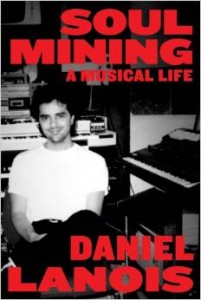 Lanois, Daniel. 2010. Soul Mining: A Musical Life. Faber & Faber.
Lanois, Daniel. 2010. Soul Mining: A Musical Life. Faber & Faber.
Lanois seems a sensitive, poetic soul in interviews, and his track record of capturing surprising, innovative work from legendary artists would suggest he’d have a lot of interesting stories and observations to share. Hence this memoir, a selective, non-linear overview of his life playing and producing music, which all began in the home studio he and his brother Bob oversaw in Hamilton, Ontario. Considering that his work on three Martha and the Muffins records was bookended by his gig co-producing U2’s Unforgettable Fire, it’s surprising that the Muffins gets no mention; nor do any of the other Canadian acts (Parachute Club, Spoons, Luba, Simply Saucer) he recorded. (Okay, not 100% true: we learn that Brian Eno discovered Lanois after coming into possession of a demo by obscure Toronto group Time Twins.) Upon closer inspection, the artistic principles that he pursue with Mark Gane and Martha Johnson are addressed here: ambient strategies, recording in non-studio spaces, and optimal dynamics for artist-producer communion. “Three people, or the triangle, is, in my opinion, the optimum for fast idea exchange. The bigger the ensemble, the bigger the ship — no fast turns, bad for spontaneity.”
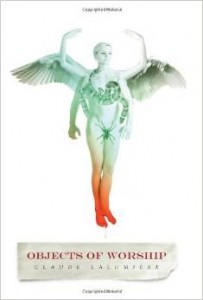 LaLumiere, Claude. 2012. Objects of Worship. New York: Harper Collins.
LaLumiere, Claude. 2012. Objects of Worship. New York: Harper Collins.
Not a book about music, but rather an anthology of short stories by a speculative fiction writer based in Montreal. The final story shares the title of Martha and the Muffins’ third album: “This is the Ice Age.” A Ballardesque environmental disaster, it spins off from the title track’s opening travelogue (Riding our bicycles down on the freeway/Leaving distorted cars trailing behind) to evoke an end-of-world scenario that the protagonists happened into in an uncanny instant (All we did was close our eyes/A world falling into shape).
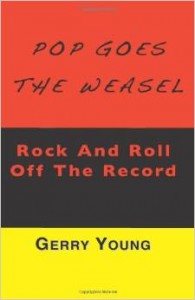 Young, Gerry. 2011. Pop Goes the Weasel: Rock and Roll Off the Record. Seattle: CreateSpace.
Young, Gerry. 2011. Pop Goes the Weasel: Rock and Roll Off the Record. Seattle: CreateSpace.
A memoir by the band’s manager, self-published on Amazon.com. The first half collects the stories Young gathered in the promotion and publicity offices of Polygram Canada, one of the many domestic subsidiaries of multinational music companies sending international artists on tour through Canada, for employees like Young to shuttle between hotel, reception, interviews, press conferences, and debauched after-concert events. (I’ll never think about Robert Fripp or 10cc the same way after this book.) The second half covers his career as head of Canadian indie Current Records and Management, a path that began with a 1980 call out of the blue from Martha and the Muffins. Young signed on as the band’s manager (taking business affairs over from bassist Carl Finkle, who soon departed) and invested his inheritance from the sale of his parents Northern Ontario cottage to keep the U.S. leg of the Metro Music tour afloat (Trout Lake gets a namecheck in “You Sold the Cottage”). By running interference with Virgin Record executives who had grown cold on the band, negotiating a three-album deal with RCA Records with healthy advances, and securing the songwriters’ publishing rights on the new recordings, Young extended Martha and the Muffins’ career well into the 1980s and laid the foundation for their on-going reissue activities.

1 comment
Narendra Motwani says:
Oct 13, 2014
Looking forward to read the books mentioned, i hope that they prove to be very useful, esp. Young, Gerry’s Pop Goes the Weasel: Rock and Roll Off the Record .Thanks for nice compilation.